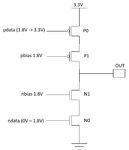dr_kca
Junior Member level 3
Relibility question for a casode 3.3V buffer using 1.8V MOS.
Hello,
In a 3.3V cascode output buffer design using 1.8V transistors (two cascoded PMOS and two cascoded NMOS as shown in the figure below), the cascode configuration is used on order to keep |Vgs| of MOS devices within the allowed voltage range. I was thinking if the same constraint is also valid for Vds? The documentation that I have does not really specify anything for Vds in terms of reliabilty, it only says that if this voltage is greater than 1.98V ( 1.8+10%) it is out of specification for SOA analysis. Is it wrong to assume that the Vds (since no oxide) limitation is more relaxed, and MOS can tolerate a few hundreds of milivolts of over-voltage between its drain and source for a short interval during a switching activity due to the short-circuit current when both P and N is ON ? This latter assumption is it a problem for PBTI/NBTI phenomena?
PMOS have a slower switching response than NMOS due a fail-safe structure, which is not shown in the figure below. This structure causes a short-circuit current that lasts longer and I was wondering until which point I should keep optimizing my buffer design.
thank you very much,

Hello,
In a 3.3V cascode output buffer design using 1.8V transistors (two cascoded PMOS and two cascoded NMOS as shown in the figure below), the cascode configuration is used on order to keep |Vgs| of MOS devices within the allowed voltage range. I was thinking if the same constraint is also valid for Vds? The documentation that I have does not really specify anything for Vds in terms of reliabilty, it only says that if this voltage is greater than 1.98V ( 1.8+10%) it is out of specification for SOA analysis. Is it wrong to assume that the Vds (since no oxide) limitation is more relaxed, and MOS can tolerate a few hundreds of milivolts of over-voltage between its drain and source for a short interval during a switching activity due to the short-circuit current when both P and N is ON ? This latter assumption is it a problem for PBTI/NBTI phenomena?
PMOS have a slower switching response than NMOS due a fail-safe structure, which is not shown in the figure below. This structure causes a short-circuit current that lasts longer and I was wondering until which point I should keep optimizing my buffer design.
thank you very much,
